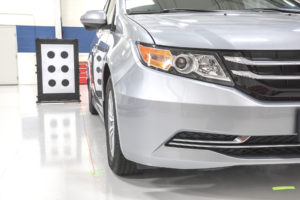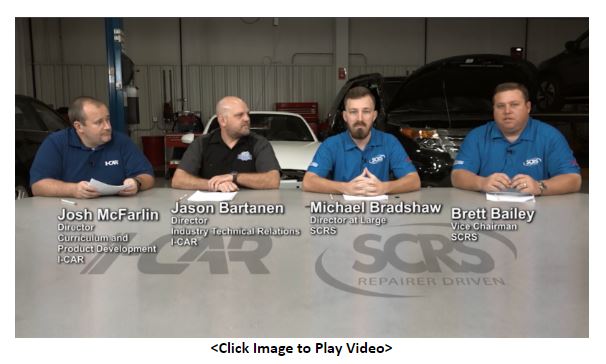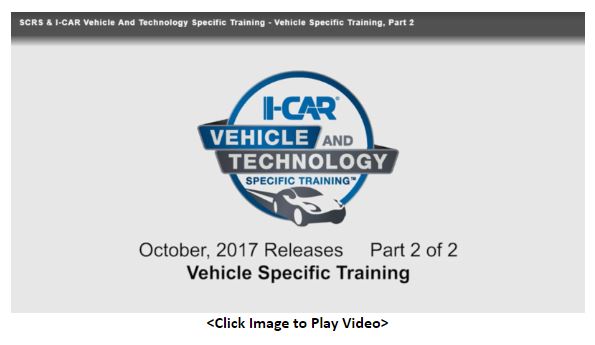
AirPro, I-CAR/SCRS video: Dealerships might not always be prepared for ADAS recalibration
By onAnnouncements | Associations | Business Practices | Education | Repair Operations | Technology
Collision repairers might need to prepare for the possibility that even an OEM-affiliated dealership isn’t completely prepared for calibrations of advanced driver assistance systems, experts suggested last week.
AirPro operations executive director Chuck Olsen described such a situation at the Collision Industry Conference on Jan. 18.
Olsen said he had just received an email from a client who needed radar and camera calibration on a Toyota, but the client’s dealership didn’t have anyone trained on the procedures.
“They’re going to be down three days,” Olsen said. “… They want to bring this in-house.”
He said that in his opinion, dealerships “haven’t been exposed enough” to the procedures, which are necessary to ensure safety systems like autobraking are correctly interpreting the road and traffic around them after a collision repair or glass installation.
He attributed the lack of familiarity to the lack of service ADAS sensory technology needs under ordinary conditions.
“They don’t require maintenance,” Olsen said. “They don’t break down.”
Society of Collision Repair Specialists board member Michael Bradshaw and I-CAR industry technical relations director Jason Bartanen also raised the issue during a joint video published by I-CAR the day before.
Often, “you have to train the dealership,” Bradshaw (K&M Collision) said in the film posted Jan. 17 during a discussion of the technology covered in I-CAR’s VT215E01 course (“rearview cameras, 360-degree view camera systems, and night vision cameras,” according to I-CAR).
The dealership might not have done many recalibrations — if any, he said.
The shop must explain the dealership the steps of the actual calibration process, he said.
Regardless of experience, a dealership might not even be equipped to calibrate a vehicle. “We’ve had to move a car from one dealer to another,” Bradshaw said; the first facility lacked equipment like calibration targets, he said.
“That’s been our experience a little bit too,” Bartanen said, noting that dealers might be trained but looking at warranty repairs.
A representative for the auto industry pointed out that dealerships were trying to keep up with the rapidly changing vehicle fleet, just like collision repairers.
“The examples referenced highlight the fact that dealers face many of the same issues that collision repair shops face,” Alliance of Automobile Manufacturers state government affairs senior director Wayne Weikel wrote in an email. “… Technology is helping make vehicles safer than ever before, but that same technology generates many challenges for a service department. When you add in the struggle to keep high performing technicians or hiring and training their replacements, what you find is that – while our members expect their dealer body to be service-ready for every vehicle in the linemake – it’s an ongoing effort.
“That said, in the end, a shop needs to treat the outsourcing of advanced driving systems calibration just like any other service. You need to find a vendor that can provide you with what you need when you need it. There may be situations when the dealer located closest to the shop is not their best option. It’s a competitive marketplace, so you have to think that losing a shop’s business will encourage any dealer to evaluate their practices.”
SCRS Vice Chairman Brett Bailey (A&B CARSTAR) said in the video that “nearly every car” in his shop has some kind of calibration requirement. He said that if a shop relies on a third party, they should ensure that third party is qualified but still take the time to educate themself.
“Know those procedures,” Bailey said.
Bartanen agreed, saying it was important to know the reason for each calibration step and how the system should be functioning in a test drive.
Asked by I-CAR curriculum and product development director Josh McFarlin if this had bearing on who in the shop needed to know the information, Bradshaw said knowledge of ADAS calibration wasn’t as vital for a technician if they wouldn’t be doing the work in-house. However, a blueprinter or estimator really needed to know it, he said.
Bradshaw suggested a best practice of “always pull the procedure” and have the knowledgeable party at the shop contact the dealership to walk them through it. Often, his shop is the first or only shop to bring such work to the dealership, he said.
“Everybody in the shop needs to know,” Bailey said — even a detailer, he said. In the past, pulling a bulb was a 10-minute job, according to Bailey. But today, with an adaptive headlight, it could take 10 minutes to an hour or 90-minute process.
Check out the I-CAR video here and Part 2 here, and examine what McFarlin described as the nine, hour-long “to-the-point” online courses mentioned within it here.
More information:
“I-CAR and SCRS Release New Videos”
Society of Collision Repair Specialists, Jan. 17, 2018
I-CAR 2018 vehicle technology courses
I-CAR OEM Calibration Requirements Search portal
OEM1Stop OEM repair procedure portal
Images:
A target is placed behind a vehicle to recalibrate a lane-watching camera’s aim. (Provided by I-CAR)
Two new videos released by the Society of Collision Repair Specialists and I-CAR on Wednesday showcase nine new vehicle technology courses but largely examine what the underlying subject matter could mean for your shop. From left, I-CAR curriculum and product development director Josh McFarlin and I-CAR industry technical relations director Jason Bartanen appeared along with SCRS board member Michael Bradshaw (K&M Collision) and Vice Chairman Brett Bailey (A&B CARSTAR). (Screenshot from I-CAR and SCRS video)
Two new videos released by the Society of Collision Repair Specialists and I-CAR on Wednesday showcase nine new vehicle technology courses. (Screenshot from I-CAR and SCRS video)


